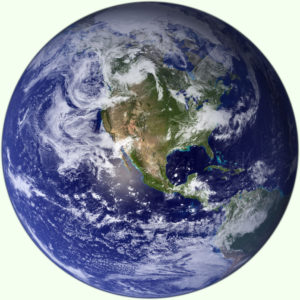[DRAFT]
Myths are really about the nature of nature —Robert Bringhurst
nce upon a time, there was a planet that spun round and round in the empty blackness of cosmic space. Of course this is what planets do – spin round and round I mean – so nothing special there.
Still, this particular planet was in many ways a cosmic stand-out, a superstar among terrestrial worlds. In short, it gleamed with the lively gleam which is the mark of Life, a thing of beauty unspeakable. Nobody who once glimpsed this Living World, this planet Earth, this bright blue visage turning majestically there in the blackness, gleaming blue and green and tan, all enveloped in its celestial aura, ever forgot it.
Now it happened that the surface of this life-giving planet teamed with trillions of creatures numbering in the billions of different kinds. The great majority of these different kinds were microscopic in size and lived on the insides of things, not least the surface of the planet itself. At the other end of the continuum were a few tens of thousands of species who, if they chanced to fall, say, even 100 metres through space, would splat.
Not the least inconsequential of these latter species was an enterprising creature notably described by some as a featherless biped, by others as a forked radish, and by others still as trouble. These of course were the humans, or Homo sapiens if you prefer.
When we catch up with these humans, things are looking a bit down. Indeed, it’s lately begun to dawn on the more astute among them that their future on this earthen planet no longer beckons as it once did – any more than the prospect of falling head-most down the face of a frowning, splat-worthy precipice would usually seem to beckon.
Looking back, it occurred to some that certain asymmetries in the relation of power to wisdom, their prevailing cultural credo – Excelsior – that it was this, finally, that brought them to this splatworthy pass.
Now in the days of their ancestors, these humans learned, by trial and error mostly, that it was best to make do with enough. No Excelsior for them. Life was not always easy in those days, yet it was sugar-coasted in meaning and the land, like the planet, was beautiful beyond words, so nobody thought to complain.
Much had been lost that should not have been forgotten; and instead of reading the land written in the hand of the Living World, they had taken to reading books written by other people instead.
As fate would have it, the turn to books came about the same time when some early mathematically minded scientists looked out at the universe and saw, not a universe, but mathematical formulae, a machine, a wind-up watch. (Silly people: who could possibly mistake the universe for a watch of all things?)
From this they decided that God – the god they imagined in their heads, a god bearing no resemblance to any real god living or dead – must be on some sort meditation retreat, sitting there up in the sky, in heaven, there on his golden throne, simply watching the universe tick-tock away as though he didn’t have better things to do with his time. And who can say, perhaps they were onto something.
Still, these were people of the book, remember. So we shouldn’t be too surprised if they thought, a silly idea really, that reading books was the same as touching the Living World itself. Nor should we get tied up in knots if one among their number, a book-learned bloke, one day came along and pronounced the following words: As it is done in heaven, so let it be done on Earth.
Whew, was that a mistake or what!
Anyhow, and so it was done.
STAY TUNED FOR PART II

